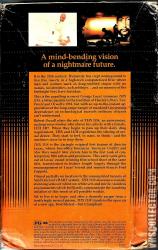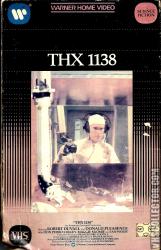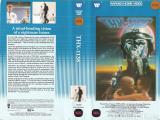THX-1138
Catalog Number
11162
-
Primary Distributor (If not listed, select "OTHER")
Catalog Number
11162
Primary Distributor (If not listed, select "OTHER")
Release Year
Country
88 mins (NTSC)
N/A | N/A | N/A
N/A | N/A
THX-1138 (1971)
Additional Information
Additional Information
Visit the future where love is the ultimate crime.
The Future is here.
A Love Story Filmed on Location in the 21st Century
Based on his award-winning student short, George Lucas's debut feature cerebrally celebrates the possibility for individual freedom against all odds. In a 1984-esque white-washed future underground dystopia where sexuality is banned, all humans sport shaved heads and the same shapeless outfits as they go about their work in a mandated state of sedation, listening to exhortations to "Buy and Be Happy." Black-clad robot cops chant a mantra to their victims that "everything will be all right" and automated confessional booths emit soothing therapeutic bromides. But unbeknownst to THX 1138 (Robert Duvall), his roommate LUH 3417 (Maggie McOmie) has been reducing their meds, resulting in their mutual discovery of love and THX's subsequent imprisonment for drug evasion and sexual misconduct. Determined to find the pregnant LUH, THX breaks out of prison with the help of his cellmate SEN 5241 (Donald Pleasence) and an escaped TV hologram (Don Pedro Colley). With fugitive pursuits strictly budgeted, THX only has to evade the robocops until the funds run out, but surveillance is omnipresent and THX's vehicle keeps overheating. Making the only film produced through the first incarnation of Francis Ford Coppola's independent studio American Zoetrope, Lucas and his small crew, including co-writer and sound editor Walter Murch, shot THX 1138 in northern California with no interference from distributor Warner Bros. When Warners saw the austere result, however, they recut the film before its release. Neither the studio's nor Lucas's cut was a popular success, but THX 1138's coolly minimalist style and story-telling gained fans on the college screening circuit, just as Stanley Kubrick's poetic 2001: A Space Odyssey had attracted a large youth audience in 1968. When Lucas returned to sci-fi after American Graffiti, he traded restraint for nostalgic fun in the film that guaranteed his creative freedom in Hollywood: Star Wars. ~
THX 1138 is a 1971 science fiction film directed by George Lucas in his feature directorial debut. The film was written by Lucas and Walter Murch. It stars Robert Duvall and Donald Pleasence and depicts a dystopian future in which the populace is controlled through android police officers and mandatory use of drugs that suppress emotion, including sexual desire.
THX 1138 was developed from Lucas' student film Electronic Labyrinth: THX 1138 4EB, which he made in 1967 while attending the University of Southern California's film school. The feature film was produced in a joint venture between Warner Brothers and Francis Ford Coppola's production company, American Zoetrope. A novelization by Ben Bova was published in 1971. The film received mixed reviews from critics and failed to find box office success on initial release, however the film has subsequently received critical acclaim over the years and gained a cult following.
THX 1138 was released to theaters on March 11, 1971 and was initially commercially unsuccessful, earning back $945,000 in rentals for Warner Bros, but still leaving the studio in the red.[14] Critical reception was mixed at the time of its release. A contemporary survey of reviews found 7 favourable, 3 mixed, and 5 negative.[15]
The film, however, started to receive positive reviews over the years and gained critical acclaim. As of 2014, the film is rated "fresh" on the review aggregator Rotten Tomatoes with a score of 90% and an average rating of 7/10. The consensus reads, "George Lucas' feature debut presents a spare, bleak, dystopian future, and features evocatively minimal set design and creepy sound effects."[16]
The significance of the name THX 1138 has been the subject of much speculation. In an interview for the DVD compilation Reel Talent, which included Lucas's original 4EB short, Lucas stated that he chose the letters and numbers for their aesthetic qualities, especially their symmetry.[23] According to the book Cinema by the Bay, published by George Lucas Books, Lucas named the film after his telephone number while in college: 849-1138 - the letters THX correspond to the numbers 8,4 and 9 on the keypad.[24] Walter Murch states in the DVD's audio commentary that he always believed Lucas intended THX to be "sex", LUH to be "love", and SEN to be "sin".[7] John Lithgow, in "The Film School Generation" segment of the DVD series American Cinema, described the title THX 1138 as "reading like a license plate number."[25]
Release Date: March 12, 1971
Distrib: Warner Brothers
The Future is here.
A Love Story Filmed on Location in the 21st Century
Based on his award-winning student short, George Lucas's debut feature cerebrally celebrates the possibility for individual freedom against all odds. In a 1984-esque white-washed future underground dystopia where sexuality is banned, all humans sport shaved heads and the same shapeless outfits as they go about their work in a mandated state of sedation, listening to exhortations to "Buy and Be Happy." Black-clad robot cops chant a mantra to their victims that "everything will be all right" and automated confessional booths emit soothing therapeutic bromides. But unbeknownst to THX 1138 (Robert Duvall), his roommate LUH 3417 (Maggie McOmie) has been reducing their meds, resulting in their mutual discovery of love and THX's subsequent imprisonment for drug evasion and sexual misconduct. Determined to find the pregnant LUH, THX breaks out of prison with the help of his cellmate SEN 5241 (Donald Pleasence) and an escaped TV hologram (Don Pedro Colley). With fugitive pursuits strictly budgeted, THX only has to evade the robocops until the funds run out, but surveillance is omnipresent and THX's vehicle keeps overheating. Making the only film produced through the first incarnation of Francis Ford Coppola's independent studio American Zoetrope, Lucas and his small crew, including co-writer and sound editor Walter Murch, shot THX 1138 in northern California with no interference from distributor Warner Bros. When Warners saw the austere result, however, they recut the film before its release. Neither the studio's nor Lucas's cut was a popular success, but THX 1138's coolly minimalist style and story-telling gained fans on the college screening circuit, just as Stanley Kubrick's poetic 2001: A Space Odyssey had attracted a large youth audience in 1968. When Lucas returned to sci-fi after American Graffiti, he traded restraint for nostalgic fun in the film that guaranteed his creative freedom in Hollywood: Star Wars. ~
THX 1138 is a 1971 science fiction film directed by George Lucas in his feature directorial debut. The film was written by Lucas and Walter Murch. It stars Robert Duvall and Donald Pleasence and depicts a dystopian future in which the populace is controlled through android police officers and mandatory use of drugs that suppress emotion, including sexual desire.
THX 1138 was developed from Lucas' student film Electronic Labyrinth: THX 1138 4EB, which he made in 1967 while attending the University of Southern California's film school. The feature film was produced in a joint venture between Warner Brothers and Francis Ford Coppola's production company, American Zoetrope. A novelization by Ben Bova was published in 1971. The film received mixed reviews from critics and failed to find box office success on initial release, however the film has subsequently received critical acclaim over the years and gained a cult following.
THX 1138 was released to theaters on March 11, 1971 and was initially commercially unsuccessful, earning back $945,000 in rentals for Warner Bros, but still leaving the studio in the red.[14] Critical reception was mixed at the time of its release. A contemporary survey of reviews found 7 favourable, 3 mixed, and 5 negative.[15]
The film, however, started to receive positive reviews over the years and gained critical acclaim. As of 2014, the film is rated "fresh" on the review aggregator Rotten Tomatoes with a score of 90% and an average rating of 7/10. The consensus reads, "George Lucas' feature debut presents a spare, bleak, dystopian future, and features evocatively minimal set design and creepy sound effects."[16]
The significance of the name THX 1138 has been the subject of much speculation. In an interview for the DVD compilation Reel Talent, which included Lucas's original 4EB short, Lucas stated that he chose the letters and numbers for their aesthetic qualities, especially their symmetry.[23] According to the book Cinema by the Bay, published by George Lucas Books, Lucas named the film after his telephone number while in college: 849-1138 - the letters THX correspond to the numbers 8,4 and 9 on the keypad.[24] Walter Murch states in the DVD's audio commentary that he always believed Lucas intended THX to be "sex", LUH to be "love", and SEN to be "sin".[7] John Lithgow, in "The Film School Generation" segment of the DVD series American Cinema, described the title THX 1138 as "reading like a license plate number."[25]
Release Date: March 12, 1971
Distrib: Warner Brothers
Related Links
Related Releases2
Catalog Number
11162
Primary Distributor (If not listed, select "OTHER")
THX-1138 (1971)
Release Year
Catalog Number
11162
Primary Distributor (If not listed, select "OTHER")
Catalog Number
11162
Catalog Number
11162
Primary Distributor (If not listed, select "OTHER")
THX-1138 (1971)
Release Year
Catalog Number
11162
Primary Distributor (If not listed, select "OTHER")
Catalog Number
11162











Comments0
Login / Register to post comments